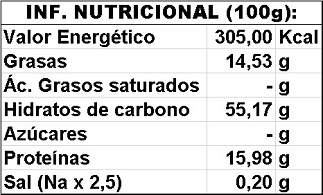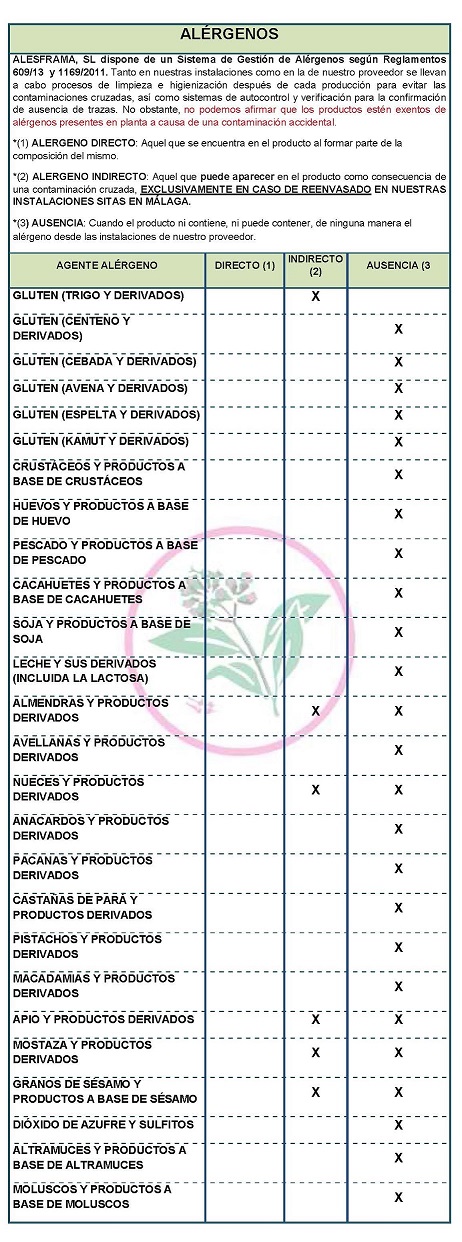My baskets
You still don't have anything in your shopping cart
My baskets
You still don't have anything in your shopping cart

{{getOldPrice()}}{{getPrice()}}
 ¡ Buying this product you get {{calculatedProductMenttos()}} menttos !
¡ Buying this product you get {{calculatedProductMenttos()}} menttos !

Without gluten

Without gluten
Dill seeds (Anethum graveolens Linnaeus) dried. Aromatic, they produce a warm mouthfeel.
Known since ancient times, Dill cultivation is becoming more and more widespread in countries where it was previously unknown. Sits main consumption is as a spice and fresh. Also, for its properties, it is used in herbalism.
Dried dill seeds (Anethum graveolens Linnaeus). Aromatic, they produce a warm sensation in the mouth.
Known since ancient times, the cultivation of Dill, is becoming more and more widespread in countries where it was previously unknown. Its main consumption is as a spice and fresh. Also, for its properties, it is used in herbalism

* The salt content corresponds exclusively to the sodium naturally present in the food
The salt content corresponds exclusively to the sodium naturally present in the food
Storage
Keep in a cool, dry place, away from strong odors and sources of contamination
Storage
DECLARATION OF ALLERGENS
DECLARATION OF ALLERGENS
According to the technical data sheet of the supplier(s):
Contains NO GLUTEN AS AN INGREDIENT, BUT THE ABSENCE OF TRACE CANNOT BE GUARANTEED.
ALLERGENS:
Contains no allergens as ingredients
Because of cross-contamination may contain Celeriac, nuts, mustard and sesame.
At both our facilities and our supplier's, cleaning and sanitizing processes are carried out after each production to avoid cross-contamination, as well as self-monitoring and verification systems for the confirmation of absence of traces,. However, we cannot claim that the products are free of allergens present in the plant due to accidental contamination
COMMUNITY DIRECTIVE 2006/142/EC ON INGREDIENTS AND LABELLING OF ALLERGENS According to directive 2003/89/EC below is a list of allergenic ingredients that must be mentioned in the labeling for the purpose of consumer protection since the presence of these substances can cause allergies. DECLARATION OF NOT GENETICALLY MODIFIED 
APPLICABLE LEGISLATION
APTITUDE FOR ETHNIC GROUPS AND OTHERS:
HALAL FITNESS : YES, official certificate not available
DIABETICS SUITABILITY : YES
FIT FOR VEGETARIANS : YES
FIT FOR VEGANISTS : YES
FIT FOR VEGANS : YES
CELIACS SUITABILITY : NO
NOT SUITABLE FOR CELIACS : NO
Dill seeds (Anethum graveolens Linnaeus) dried. Aromatic, they produce a warm mouthfeel.
Known since ancient times, Dill cultivation is becoming more and more widespread in countries where it was previously unknown. Sits main consumption is as a spice and fresh. Also, for its properties, it is used in herbalism.
Dried dill seeds (Anethum graveolens Linnaeus). Aromatic, they produce a warm sensation in the mouth.
Known since ancient times, the cultivation of Dill, is becoming more and more widespread in countries where it was previously unknown. Its main consumption is as a spice and fresh. Also, for its properties, it is used in herbalism

* The salt content corresponds exclusively to the sodium naturally present in the food
The salt content corresponds exclusively to the sodium naturally present in the food
Storage
Keep in a cool, dry place, away from strong odors and sources of contamination
Storage
DECLARATION OF ALLERGENS
DECLARATION OF ALLERGENS
According to the technical data sheet of the supplier(s):
Contains NO GLUTEN AS AN INGREDIENT, BUT THE ABSENCE OF TRACE CANNOT BE GUARANTEED.
ALLERGENS:
Contains no allergens as ingredients
Because of cross-contamination may contain Celeriac, nuts, mustard and sesame.
At both our facilities and our supplier's, cleaning and sanitizing processes are carried out after each production to avoid cross-contamination, as well as self-monitoring and verification systems for the confirmation of absence of traces,. However, we cannot claim that the products are free of allergens present in the plant due to accidental contamination
COMMUNITY DIRECTIVE 2006/142/EC ON INGREDIENTS AND LABELLING OF ALLERGENS According to directive 2003/89/EC below is a list of allergenic ingredients that must be mentioned in the labeling for the purpose of consumer protection since the presence of these substances can cause allergies. DECLARATION OF NOT GENETICALLY MODIFIED 
APPLICABLE LEGISLATION
APTITUDE FOR ETHNIC GROUPS AND OTHERS:
HALAL FITNESS : YES, official certificate not available
DIABETICS SUITABILITY : YES
FIT FOR VEGETARIANS : YES
FIT FOR VEGANISTS : YES
FIT FOR VEGANS : YES
CELIACS SUITABILITY : NO
NOT SUITABLE FOR CELIACS : NO
